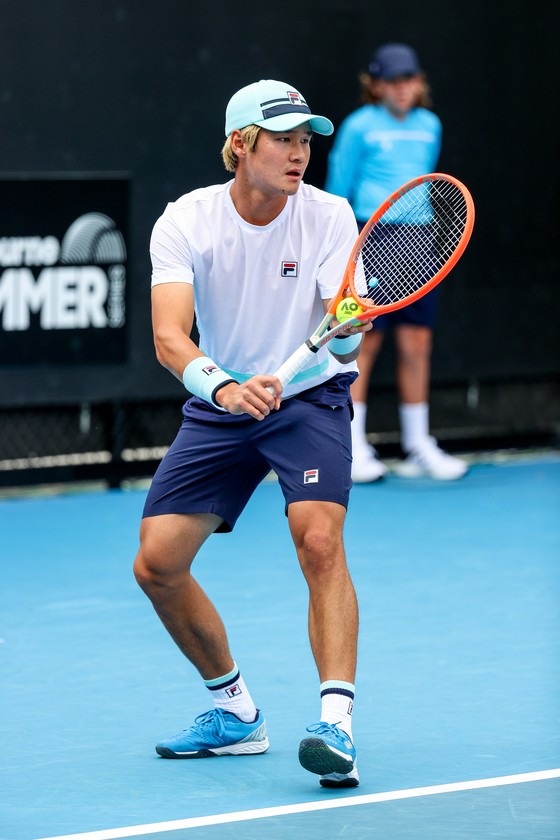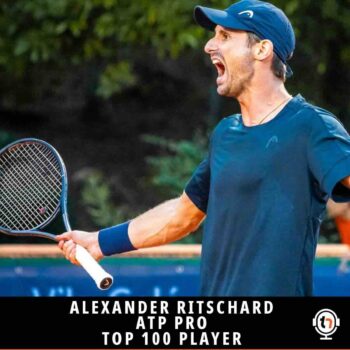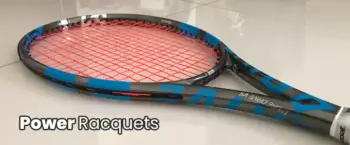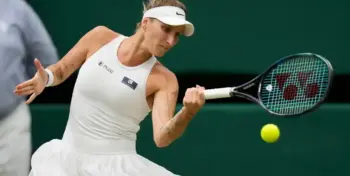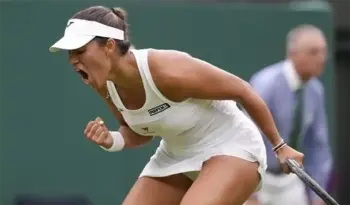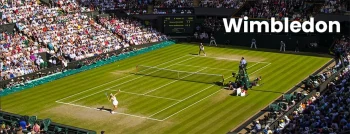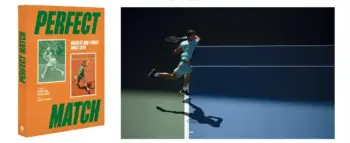Our resident analyst and creative writer, Evan Gaudreau, is back with a match analysis. This time Ivashka vs Kwon. Enjoy!
Check out Evan’s other pieces here. Ivashka vs Kwon – 3-6 2-6. Gaudreau has his view on how it happened and finds one particular flaw in Ivashka’s game. Over to Evan.
99 bottles of beer on the wall
This piece is sponsored by Greater Good, Pulp Daddy, the Nectar of the Hop Gods.
“99 bottles of beer on the wall, 99 bottles of beer, take one down, pass it around, 98 bottles of beer on the wall.”
And, we begin. I picked a random match. Kind of. I watched Ilya Ivashka play FAA a few weeks ago, and I was surprised to see that he was in the top fifty, but I did some digging and looked at last years’ results and was impressed. By the results, only.
Did you know he has a technical flaw, most likely developed from youth? It’s funny how things chase us from childhood. More like haunt us.
The flaw I saw seemed obvious. I don’t know why it’s not exposed more. Maybe it is. Sometimes, I wonder if I’m talking Spanish. Probablemente sea el lupulo. It’s probably the HoPs. On the other hand, I have never watched Kwon, and I was also surprised where his ranking sat in a good way. First things first.
The patterns of play

These pieces bug me because I want to get more in-depth and talk about the patterns, but something always gets in the way when looking at players outside the top 5 guys or 10. It’s the same when you look at college players. When you drop from D1-D3, some weird technical flaw pops up.
Kwon’s first service game. The first game was a wash, other than a lone short ball (Mixed with three aces). The short ball is only important because of where he put it. To Ivashka’s forehand corner.
1) He was up 30-0 at the time and could afford to lose the point if something silly happened.
2) Ivashka turned his hips to the left and headed to the backhand corner.
Why? Probably because everyone and their brother goes after his backhand. He gave him a probe. I always make a mental note of where the first short ball goes. What is the player trying to establish?
Ivashka’s first serve game.
12 points.
The first thing that popped up was Ivashka had 40-15 and dumped a second ball in the net on the first game point and then the first ball in the net on the second game point. 0-2 Conversion rate. So far. Those bug me. Mental mistakes.
What was he trying to do? Just get the ball back in the court and play for a miss? Was he thinking about moving his feet? (You’ll see later, maybe the best play for him when up two points is to be aggressive with the first shot and pressure the opponent by following it in? What do I know?).
It’s funny for me when I watch the vid and break down players, I can see their training in the way they play. Doesn’t everybody? Ivashka looks cut in half to me…like he’s a baseliner, but also a volleyer, but not both. What I mean is there is a disconnect, a hesitation in his game like all his training is either behind the baseline or way up at the net. I’m opening another door here. Bear with me.
Have you ever heard of the band Okkervil River? Put them on and play “Down Down The Deep River.” It will help you understand the rest. Not really, but it’s a good song and goes well with Greater Good.
A man with two games
If you watch the match, you’ll see that Ivashka “freaks” at the baseline and comes in on rags (pocket deuces in poker) and hopes for the best. He’s not a bad volleyer, though. And he’s 6’4”.
I guess I feel the disconnection of his points is because the serve + ones are hurting him and makes me think of the disconnection between his baseline play and his netplay. Almost like he’s confused. Do I hit the ball back and rally? Or do I attack and follow the ball to the net?
Conversion rate (game points are an issue. Closing the games).
Ivashka 0/2
Kwon 1/3
This match, in some ways, was frustrating to watch. (But the music I’m playing is good.) The patterns never build because there were so many missed returns in between the actual points. I call this red light/green light. Or green light/red light.
Or whose on first. Kwon missed double returns in the last three games. At 15-all in Game 4, he missed two in a row. At the start of Game 6, he missed the first two returns (and finished the game with one). At Game 8, he missed two in a row at 0-40 and ended up losing the game.
Meanwhile, Ivashka missed three Serve + 1’s in his first service game at 40-15 and another one at deuce, in game 2, and got broken. Missed another first ball to start Game 4 and a 2nd ball at 40-30 to go back to deuce, but got out of it. Missed another 2nd ball at 40-15, but got away with a Kwon missed return for the game. I don’t want to talk about the last service game.
But I will, briefly. Ivashka got out of a 0-40 game by two missed returns and an unforced on the next point. The missed returns are starting to annoy me. Why? If Kwon had returned better, the match could have been quicker.
No returns
Why did both players miss so many makable returns? For you kids at home, Greater Good is adult soda. #2 cracked open. That’s the limit. Just saying.
Side thought: How are these guys able to overcome a technical flaw and become top 50 in the world? Answer: $$$$ Money has to be part of the issue. I mean the funding of players. I wish I could do a background check on the top 100 players and then go to, say, the guys around 500-600. There has to be a discrepancy. Money talks, (something else walks). Also, the recruitment of talent. The freebies offered by coaches or academies to players with potential.
Hmm. I might cry. I think of my junior days and how I was used as a hitter for the $$$ players. I didn’t mind though, until I woke up. The dirty side of the game.
The missed returns make me think of how they train. One drill I hated as a player (and I see done at the junior and college level) is when someone serves from the opposite side service line. Or even closer. Or even on the same side as me. This never worked for me because the timing was weird. I liked hitting “real” returns.
Did you know that hand feeds cause injuries down the road? Think about it, you’re hitting a static ball and over time you have to generate your own pace, using more of your wrist and arm and Voila! Wrist and elbow pain.
Returns returns
Returns! Oh Yeah.
I remember being “lazy” with my daughter on the court one day. I used these types of return drills with her and she knocked the crap out of the ball. Not really. But she didn’t miss too much. Even had a good streak going. I go back to the opposite baseline to hit serves and she struggled returning. Which lead me to the next drill.
I play a game with her where I can serve anywhere in the box and she has to start by getting 5 in play. Then 10. But, you can make it tough if you want it to be. Or not.
Picture this: I’m insecure. I need validation. I might be the parent in the window or on the court or the coach who’s grinding in the everyday operations. Did I ever tell you it all starts at home? Anyway.
So I ease up on the drill. Player looks like an all-star in practice, but in matches…well, that’s another story. It’s amazing how many parents bring all their crap onto their kids. Going to tournaments is like hanging around a loony bin. And Ray Finkle is the mayor! Ace Ventura? Pet Detective? No? Ok. Back to the drill.
I may even throw an underhand serve at her to be annoying.
I’m thinking Ivashka’s and Kwon’s coaches must do those weird drills. There’s no variation from up close. The timing is almost the same every time and the spin variation is not much different either. But I get it. A long day at the job, breaking bricks and pounding dirt make the coach tired. You don’t want to overuse the hitter too.
Technically, I was also wondering if their hands were too far in front of their body, which causes a timing lag on the return. Just look at Federer. His hands are closer to his body and there’s less that can go wrong.
Go try it.
#3 Cracked open. And Ivashka’s backhand
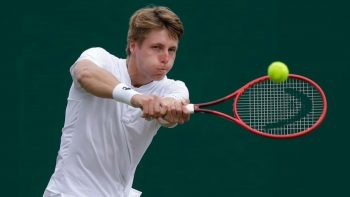
JK. Limits are limits.
Here’s the best drill of all time. Listen clearly.
Shotgun an adult drink. Diego Schwartzman serves at you. “May the Schwartz be with you” Shotgun another. Then maybe Steve Johnson & Johnson serves at you. Shotgun another. Don’t let Jack Sock serve. No! No! No! Or anyone else for that matter. Go sleep it off. Rather, come back the next day and then get back to work.
Oh crap! I forgot to talk about that flaw I found on Ivashka. Watch his backhand. He stamps out his lead foot a bit heavy. He gets stuck. That’s why Felix picked on that a few weeks back.
Quick combos and stretch combos work against those players. It helps to get the ball deep also. If you’re a pro on tour, watch the match between Ivashka and Felix at Marseille. Check out Felix’s quick combo patterns he used against him. Classic.
He mixes up his 4 ball combos. Ivashka gets turned upside down and all around.
It is 11:25 pm and you know what that means. I’m tapping out. Zzzzzzzzzz.
